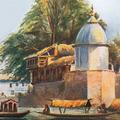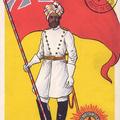Barian Bazaar (Snow)
Snow blankets Barian, a town near Murree hillstation in the Punjab. Baljee was an army photographer based in Murree whose large albumen prints (note the title in the negative at the bottom left) were published as coloured collotype postcards.



![[Movie Ad Card] [Movie Ad Card]](https://www.paperjewels.org/sites/default/files/styles/square_thumbnail/public/slides/movie-ad_0.jpg?itok=KXIUT7fC)






